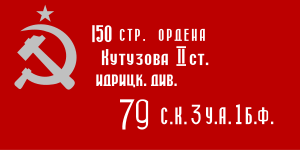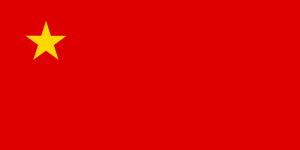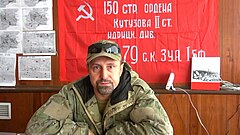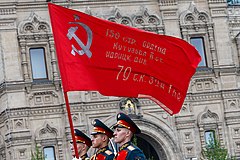You can help expand this article with text translated from the corresponding article in Russian. (May 2022) Click for important translation instructions.
|


The Soviet Banner of Victory (Russian: Знамя Победы, romanized: Znamya Pobedy) was the banner raised by Red Army soldiers on the Reichstag building in Berlin on 1 May 1945, the day after Adolf Hitler committed suicide. This particular banner was raised by three Soviet soldiers: Alexei Berest, Mikhail Yegorov, and Meliton Kantaria, but it was not the first Soviet banner on the Reichstag, see Raising a Flag over the Reichstag for details.
The Victory Banner, made under battlefield conditions, is the official symbol of the victory of the Soviet Union over Nazi Germany during the Second World War. It is also one of the national treasures of Russia. The Cyrillic inscription reads:
150 стр. ордена Кутузова II ст. идрицк. див. 79 С. К. 3 У. А. 1 Б. Ф.
Translated and with abbreviations changed to their referents, the flag's writing means:
150th Rifle Order of Kutuzov 2nd class Idritsa Division 79th Rifle Corps 3rd Shock Army 1st Belorussian Front
Although this flag was not the only one to be hoisted on the Reichstag, it was the only survivor of all the "official" flags specially prepared to be raised there.
According to the Law of the Russian Federation, the Banner of Victory is to be stored forever in a place which provides its safety and public availability.
Origin
 The original Victory Banner is saved in the Central Museum of the Armed Forces, Moscow
The original Victory Banner is saved in the Central Museum of the Armed Forces, Moscow
The origin of the banner comes from the report of the commander of the 3rd assault army to the head of political administration of The Red Army about the fight for Reichstag and placing the Victory Banner on it, dated 2 July 1945:
The Commander of the 1st Byelorussian Front Marshal of Soviet Union comrade Zhukov ordered the troops of the 3rd Shock Army to headily enter Berlin, to secure the downtown and Reichstag and to place the Victory Banner on it. <...>
Having defeated the last enemy strongholds the troops of the army entered Berlin at 6:00 o'clock in the evening on the 21st of April 1945. <...>
After seizing the downtown the troops of the 3rd assault army penetrated the neighborhood of the Reichstag at the end of 29 of April 1945..
On the 30th of April with the sunrise they started the massive assault on the Reichstag. <...>
On the 30th of April 1945 at 14:25 (2:25 pm) the soldiers of Lieutenant Sorokin's group fought their way to the roof and reached the dome. The courageous warriors - ordinary soldier Grigorij Bulatov, Komsomol party organizer Viktor Pravotorov and partyless Senior Sergeant Ivan Lysenko, Stepan Oreshko have erected a banner, the proud flag of the Soviet Union over the German parliamentary building, a symbol of our Great Victory.
The banner hoisted over the Reichstag, burned and shot through with bullets, flew victoriously over a defeated Berlin. <...>
— Vasily Kuznetsov and Andrei Litvinov, "Chapter III. «Banner above Reichtag»". Russian archive: Second World War: B. 15 (4-5). Fight for Berlin (Red Army in the defeated Germany). Moscow: Terra. 1995.
Status in certain countries
Belarus
By decree of President Alexander Lukashenko on 6 May 1995, a duplicate of the Victory Banner was issued for duties on 9 May, 23 February and 3 July. The Flag of the USSR also holds an equivalent status. In 2011, Russia presented Belarus with one of the official copies of the Victory Banner, being kept at the Belarusian Great Patriotic War Museum.
Donetsk and Luhansk People's Republics

In the self-proclaimed separatist Donetsk People's Republic and Luhansk People's Republic on Victory Day, the Banner of Victory is utilized during military parades. In 2018, the parliaments of the DPR and LPR adopted laws "On the Banner of Victory", which established the status and legal basis for the use of copies of the Banner of Victory in the republics.
Kazakhstan
On 21 April 2010, in the Hall of Fame of the Central Museum of the Great Patriotic War in Moscow, a ceremony where a copy of the Victory Banner was handed over to the Chief of Staff of the Administrative Department of the President of Kazakhstan. This copy is kept in the Museum of Nursultan Nazarbayev. The welcoming of the banner took place on 1 May in the Park of 28 Panfilov Guardsmen in Almaty. On 6 May 2015, accompanied by a guard of honor, an exact copy of the Victory Banner, made by Russian craftsmen, was transferred to the National Archives of Kazakhstan. Later on 12 June 2015, Russia handed over another copy to the Ministry of Defense of Kazakhstan. The banner was transferred for storage to the newly opened Museum of Arms and Military Equipment of the Armed Forces of Kazakhstan in Astana. On 23 December 2015, prior to the meeting of the Council of Ministers of Defense of the CIS, Russian Defense Minister Sergei Shoigu handed over another copy of the Victory Banner to the Kazakh Minister of Defense Imangali Tasmagambetov.
Transnistria
On 21 October 2009, the self-proclaimed separatist Supreme Council of Transnistria adopted a law on equating the Victory Banner with the Transnistrian Flag. In 2014, at the Memorial of Glory in Tiraspol, an official copy of the Victory Banner was handed over to Transnistria from Russia.
Ukraine
On 21 April 2011, the Verkhovna Rada of Ukraine adopted a law which was signed by President Viktor Yanukovych that established a procedure for the official use of the Victory Banner, specifically at the Tomb of the Unknown Soldier and the Monument to the Unknown Sailor. In June of that year, the Constitutional Court of Ukraine found this law unconstitutional. On 9 April 2015, the Verkhovna Rada adopted a new law which removed all mention of the Victory Banner.
After the 2022 Russian invasion of Ukraine, Russian forces displayed the flag in numerous occupied locations, including government buildings. This was linked to both the upcoming Soviet-Russian Victory Day holiday on 9 May, as well as other forms of Soviet imagery used by Russian troops during the war as part of renewed Soviet nationalism under president Putin.
Events with the banner


Military parades
A planned part of the Moscow Victory Parade of 1945 was supposed to be the march of the Victory Banner, which was delivered to Moscow from Berlin on 20 June and was supposed to begin the procession of troops on 24 June. Despite this, the weak drill training of Yegorov, Kantaria and Stepan Neustroev forced Marshal Georgy Zhukov to not go ahead with this portion of the parade. On May 9, during Victory Day parade in Moscow, a copy of Victory Banner #5 is carried immediately behind the Russian flag by members of the Moscow Commandant's Regiment Honor and Colors Guards. (In 2015 the order was reversed.) During the Independence Day Parade and the Victory Parade in Minsk, the color guard consisting of the Flag of Belarus, the Victory Banner and the Flag of the USSR are the first to march in the parade. The Victory Banner was brought to Kyiv from Moscow in October 2004 to take part in the parade in honor of the 60th Anniversary of the Liberation of Ukraine. This is the first instance of Russia sending the banner to a former Soviet Republic. In 2015, the banner was brought to Astana (the capital of Kazakhstan) to be trooped through Kazakh Eli Square by personnel of the Aibyn Presidential Regiment in the Defender of the Fatherland Day parade on 7 May. In 2020, during the first Victory Parade held in Ashgabat, the Banner was brought from Russia to be trooped on the square near the Halk Hakydasy Memorial Complex.
Other uses
On 9 May 2017, the largest copy of the Victory Banner measuring 60 by 25 meters was deployed on Great National Assembly Square in the Moldovan capital of Chișinău. The banner was sewn at a local factory over a period of two weeks. In 2020, sailors of the Russian Northern Fleet raised the banner over distant parts of the Russian Arctic.
In philately
See also
References
- Федеральный закон от 7 мая 2007 г. № 68-ФЗ «О Знамени Победы» // Собрание законодательства Российской Федерации от 14 мая 2007 г. № 20 ст. 2369 (in Russian)
- Донесение командующего 3-й ударной армией начальнику главного политического управления Красной Армии о бое за Рейхстаг и водружении над ним знамени Победы // militera.lib.ru (in Russian)
- Россия подарила Беларуси копию знамени Победы Archived 2016-03-26 at the Wayback Machine // belarmy.by
- "Парламент ДНР принял закон о Знамени Победы" (in Russian). www.pnp.ru. Retrieved 2019-05-01.
- Закон ДНР от 7 декабря 2018 года № 03-IIНС «О Знамени Победы»
- "Закон ЛНР от 8 октября 2018 года № 273-II «О Знамени Победы»" (PDF). Archived from the original (PDF) on 2019-05-03. Retrieved 2020-08-16.
- В Алматы доставили копию Знамени Победы // q99.it
- Знамя Победы: точка или многоточие в истории ВОВ? // www.unikaz.asia
- Знамя Победы передано в Национальный архив Казахстана Archived 2016-02-07 at the Wayback Machine // newtimes.kz
- Россия передала Казахстану знамя Победы // mirtv.ru
- Фарида Шарафутдинова. Российская Федерация передала Казахстану историческую копию Знамени Победы // otyrar.kz
- Приднестровье выбрало Знамя Победы государственным символом // lenta.ru
- Янукович узаконил знамя Победы // www.lenta.ru
- КС Украины признал неконституционным использование красного знамени Победы // www.rg.ru
- Про увічнення перемоги над нацизмом у Другій світовій війн… від 09.04.2015 № 315-VIII
- Paul P., Murphy (21 April 2022). "World War II Soviet victory flag begins to appear across parts of Russian-occupied Ukraine". CNN. Retrieved 6 May 2022.
- "The first victory parade of the year. Victory Parade History: How It Was". Archived from the original on 2021-02-25. Retrieved 2020-06-30.
- "Historic Scenes, Retro Military Equipment to be Presented in Victory Parade - The Astana Times". The Astana Times. 2015-04-24. Retrieved 2017-10-20.
- "Telephone conversation with President of Turkmenistan Gurbanguly Berdimuhamedov". 12 May 2020.
- Такого мир ещё не видел: В Молдове развернули самое большое Знамя Победы // kp.md
- "Military sailors of the Northern fleet will raise the victory Banner over the Arctic | KXAN36 - Austin Daily News". 9 May 2020.



